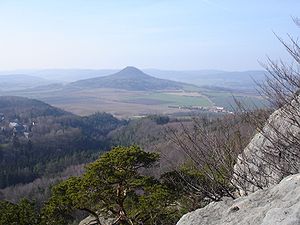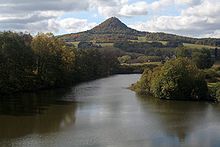Ronov
| Ronov | ||
|---|---|---|
|
View from Vlhošť to Ronov |
||
| height | 552 m | |
| location | Czech Republic | |
| Mountains | Central Bohemian Uplands | |
| Coordinates | 50 ° 37 '14 " N , 14 ° 24' 52" E | |
|
|
||
| Type | Kegelberg | |
| rock | basalt | |
| Development | Construction of the castle in the 14th century | |
The Ronov ( German Ronberg ) is a 552 m high basalt mountain in northern Bohemia ( Czech Republic ). At its peak, the ruins of a Gothic is Castle Ronov ( Ronburg ). The summit area is a natural monument on 8.73 hectares under nature protection. The view from the top of the Ronberg is one of the most beautiful in Bohemia.
Location and surroundings
The Ronberg rises between the towns of Blíževedly (lead whisk ), Stvolínky ( Drum ) and Kravaře ( Graber ) above the valley of Bobří potok .
Origin of the name
According to the Czech linguist Antonín Profous , Ron is derived from the Middle High German rone , which translates as tree trunk. On the coat of arms of the owners of the castle of the same name, the Berka von Dauba, there is a tree trunk, which underpins this language interpretation.
Castle history
It is very likely that the builders of the Ronburg were Messrs Berka von Dubá , who named the complex after their ancient family line, the Hronovici (German: Ronow ). In 1385, under King Wenzel IV , the Ronburg family was first mentioned as the owner. In 1410 the Ronburg belonged to Heinrich and Jaroslav Berka von Dauba auf Mühlstein.
In 1434 the Ronburg came into the possession of Wilhelm I of Ileburg (Eulenburg), who had been under chamberlain in the Kingdom of Bohemia since 1469. After the death of his only son Wilhelm II, the property first went to his widow Agnes, born in 1538. Countess von Helfenstein , later to their only daughter Anna, married Kurzbach , and after their death in 1554 to their sons Wilhelm and Heinrich II. Kurzbach von Trachenberg . After the latter's death in 1590, the benefit fell to his wife Eva, nee. from Wartenberg . In 1603, with the consent of the heirs, the Ronburg was sold to Elisabeth von Wartenberg at Neuschloss- Leipa . The castle had not been inhabited since 1575 because the owners at the time were based in Drum Castle .
At the beginning of the Thirty Years War, the Ronburg belonged to Adam Herzan von Harras. Like many other lordships, Wallenstein took possession of it in 1632 and incorporated it into the Duchy of Friedland . When the Swedish General Banner threatened the area in 1640, all neighboring landowners fled to this castle, which was still very solid at the time, with their valuables. The Ronburg did not withstand the attack of the Swedes, was looted and burned down in 1643 and then left to decay.
With the establishment of the diocese of Leitmeritz , the castle came into their possession. In 1654 the bishop erected a cross on the ruins and in 1845 a way of the cross was laid to the ruins (renewed in 1891).
According to legend, an underground corridor led from the Ronburg to the Helfenburg .
literature
- Franz Werner: Bleiswedel in the Sudetenland. Self-published, Cuxhaven 1966.
Web links
- Website for the castle, with a series of pictures (CZ)
- Ronburg, with photos - detailed description and history of the castle (in German).



